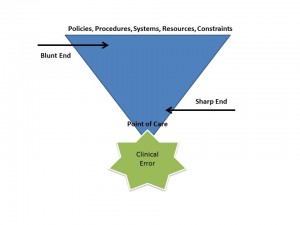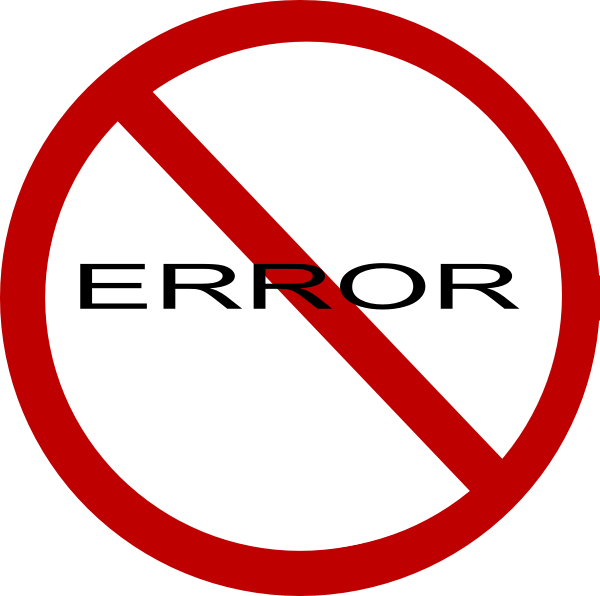How easy it is to quickly blame the actions of staff as the cause of a clinical error. After all, most errors come down to a specific staff member missing an important assessment finding or miscalculating a medication dose. Unfortunately, clinical events are rarely that simple and, when investigated, are more often the result of a combination of system, process, and individual factors. Applying models of error causation can provide a framework to determine the true causes of error events so that lasting improvement can be made. Here are four models of error causation that can help organize information when investigating an adverse event.
Active and Latent Failures
Clinical errors usually have many contributing causes, which are categorized as either active or latent failures.
- Active failures are those readily apparent causes that can be seen at the point of care. These are most often the actions taken by healthcare staff, such as the example of a nurse giving a patient the wrong dose of a medication due to a mathematical error.
- Latent failures, on the other hand, are less obvious system design flaws. These are inherent in the system, often invisible at the point of care. In the aforementioned wrong dose example, the error may have also been caused by a lack of unit dosing in the pharmaceutical operations and short-staffing that led to this nurse working a double shift and being overtired.
Blunt End and Sharp End of Clinical Error
Viewing a clinical error from the “blunt end” and “sharp end” of care delivery can also be helpful.

- The blunt end, upstream from the clinical error, involves the many complexities of the structure and processes in health care delivery that impact the point of care, but are removed from it. This corresponds to latent system failures. Examples might be staffing patterns, a culture of silence, and poor training resources for off-shift staff.
- The sharp end of clinical error is the point of patient contact; it corresponds to active system failures. In the prior wrong dose example, the sharp end of the clinical error involved the nurse’s dose miscalculation and the administration of the medication.
Swiss Cheese Model of Clinical Error
The image of the many and varied holes in Swiss cheese provides an analogy for the safety gaps in error protection that are incorporated into healthcare processes (Figure below). This model proposes that a clinical error happens when multiple “holes” line up in the layers of system protection to allow penetration of the safety system and result in harm. Layers in the system may include various components of both the blunt end and the sharp end of the patient care system, and involve both active and latent failures.
Analyzing the wrong dose medication error using this model might identify causation through inappropriate pharmacy ordering practices, incomplete staff orientation and inadequate staffing to initiate a double-check process for medications on the high-alert list. In the correctional setting, issues with custody interactions/processes, the geography of care settings within the facility, and characteristics of the patient population can add additional layers to further complicate the process.
All modern models of error causation take a systems approach – rather than a person approach – to clinical error. A person approach focuses solely on the sharp end of the process and assumes that primary responsibility rests on the individual healthcare staff at the point of care. In the person approach, an error is the result of forgetfulness, inattention, carelessness, negligence and even deliberate indifference. Research on error reduction has shown that, although the healthcare staff’s actions need to be a part of the equation, a majority of the causes of error are inherent within the health care system. Changes to the system that reduce error achieve the greatest results.
Normalization of Deviance
In a complex system involving many staff members, various equipment failures, and communication challenges, deviation from policy, procedures and protocol can become normalized. The term “normalization of deviance” was first coined during the investigation of the fatal Shuttle Challenger disaster in 1986. Inquiry revealed cases of overlooked warnings such as inclement weather forecasts and prior O-ring (a mechanical gasket) concerns. Since previous instances of these deviations did not result in injury, they were treated as normal and were not fully included in the launch decision. By cutting corners, ignoring policy, procedures and protocols, repeatedly silencing equipment alarms, and disregarding standard safety checks, deviation is normalized and becomes standard protocol in a healthcare setting.
Culture of Low Expectation
Secondary to normalization of deviance is the establishment of a “culture of low expectation.” This culture develops in a setting where team members begin to anticipate faulty behavior and incomplete communication. Instead of demanding safe procedures, participants grow accustomed to the mediocre culture and participate in it. A culture of low expectation combined with normalization of deviance further increases the risk of clinical error and patient injury.
By considering models of error causation such as active and latent failures, blunt and sharp ends, Swiss cheese, and normalization of deviance, your evaluation of clinical errors will be thorough and meaningful, and you can develop lasting change through an effective improvement plan.

Leave a Reply